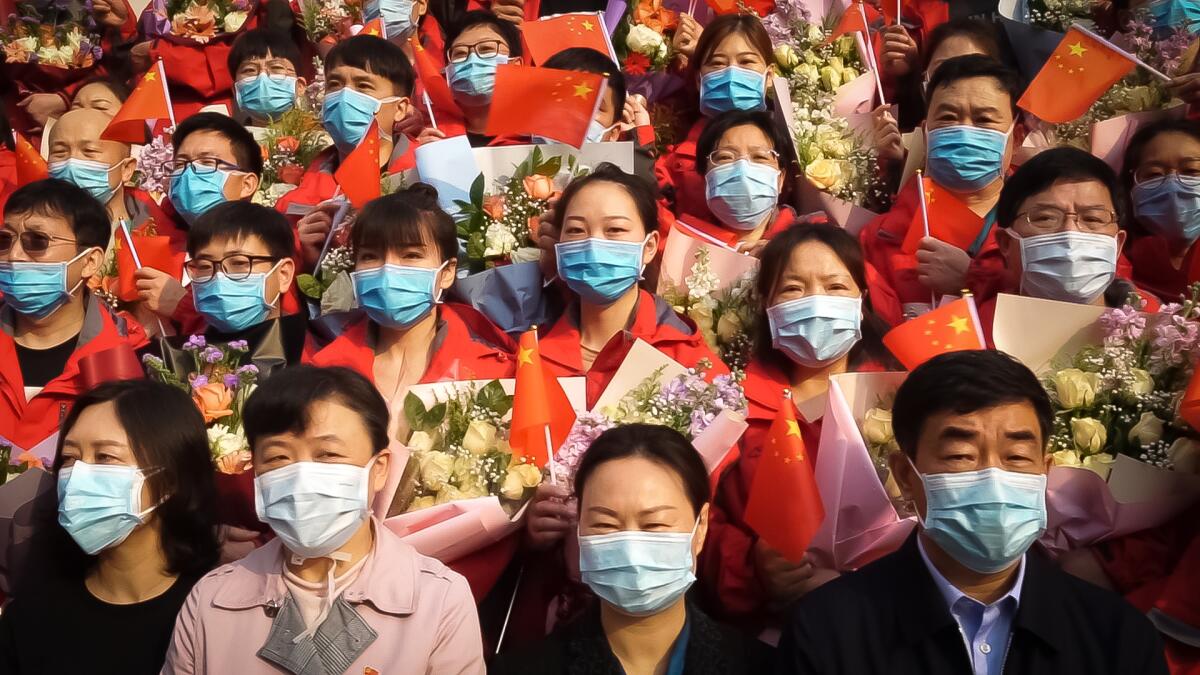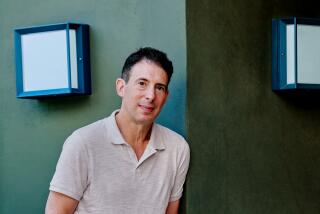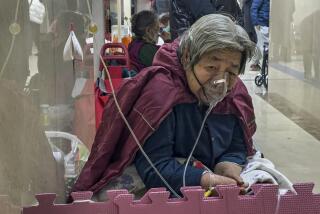Filmmaker analyzes China’s stage-managing of the COVID-19 outbreak

- Share via
A heartrending in-the-trenches account of the COVID-19 outbreak in Wuhan, China, “In the Same Breath” is driven by its vivid immersion into the chaos of the moment: nurses in biohazard garb, bodies falling in the street, a city made ghostly by a lockdown. Filmmaker Nanfu Wang, who was in China with her son visiting family for Chinese New Year in January 2020, imbues the scenes with her own pandemic story, as she analyzes how China stage-managed the catastrophe.
“It’s looking at the pandemic, but really it’s not about the pandemic,” Wang said. “Really, it’s not about the virus, it’s not about the deaths, it’s not about the illness, it’s not about the infection. None of those.”
If anything, she argues, what underlies the film — streaming on HBO Max and shortlisted in the Academy Awards’ documentary feature category — is consistent with the thematic arc sketched by two of Wang’s previous features set in China. “One Child Nation” (2019) and “Hooligan Sparrow” (2016). The former especially so, as it explored how propaganda was used to enforce a 35-year policy that restricted families to one child, “and how that policy affected people’s thinking,” Wang said, “and how the government turned that into a narrative.”
In China, the government’s narrative about the outbreak “has mostly replaced people’s actual memory,” Wang said. “What they’ve seen 24/7 on the news has become now how they remember 2020.” As the title of the film suggests, Wang complements the Chinese footage, gathered by an expansive team of camera people enlisted for the production, with a look at how her adopted home, the United States, dealt with the virus. One day, the filmmaker is startled to see workers in hazmat suits entering a house across her street in New Jersey. Her young son becomes sick, but Wang is unable to get him tested for the virus. She revisits now-familiar stories of nurses unable to get proper masks, or losing their jobs for speaking out.
What she calls her “essayistic” approach let Wang navigate through what could be a deceptive and confusing pandemic landscape. “I don’t know if diagnose is the right word,” she said, “but from very early on I had known that by simply documenting in an observational style, I wouldn’t have been able to analyze the situation in the way I’m doing.” The filmmaker also evokes unexpected empathy with the anti-mask protesters who face off with American hospital workers, quietly emphasizing how she too became tangled in confused threads of official mixed messaging. One of the film’s jarring pivots comes with Wang’s realization that despite America’s banner of freedom, its government and institutions didn’t react much differently to the crisis than did China.
Such transparency is part of the process. In one sequence, several individuals hired to shoot in China appear before the camera to explain why they took on a task that wasn’t only a health risk but could draw unwanted attention from the highly censorious Chinese government. “Being authentic and honest about everything makes it more interesting,” said Wang, explaining her rationale. But, also, the heavy hand of censorship imposes its own urgency. “It’s very special in China, because the making of the film is part of the story.”
In China, the cinematographers uploaded their footage daily as Wang edited and conducted interviews from her home. Production details tell their own story about the challenges of making a film under extraordinary conditions. “Their lenses showed their political views,” Wang said. She recalled how one person shooting in a hospital always framed from the sightline of the doctor when the filmmaker wanted the camera at the patient’s level. Despite her increasingly detailed and explicit requests, the footage each day was the same. Finally, the cameraman explained why. For him, Wang said, “‘doctors are heroes. The government is acting so quickly.’ He loved the government. This was a proud moment of the hero saving the city.”
Wang also caught glimpses of unexpected poetry in the least likely places. She reflects on footage taken by another cinematographer, a locked-off shot in a hospital room. “He filmed an air-conditioner fan spinning,” she said. “He did three different angles of the same thing. I felt really touched.” The patient was motionless, inside a sealed hospital, inside a sealed city. “The fan circulating air between outside and inside,” the cameraman told Wang, “was the only connection between that world and this world.”
The film’s uncensored images made an impact, she said, provoking “the most sensitive reaction I’ve gotten” from the Chinese government. The focus of “One Child Nation” was in the past, and “Hooligan Sparrow” considered a lone activist. Now, Wang said, “there is so much at stake. China is trying to show the world it handled the pandemic effectively. Any narrative that counters that to them was a threat.”
More to Read
From the Oscars to the Emmys.
Get the Envelope newsletter for exclusive awards season coverage, behind-the-scenes stories from the Envelope podcast and columnist Glenn Whipp’s must-read analysis.
You may occasionally receive promotional content from the Los Angeles Times.










